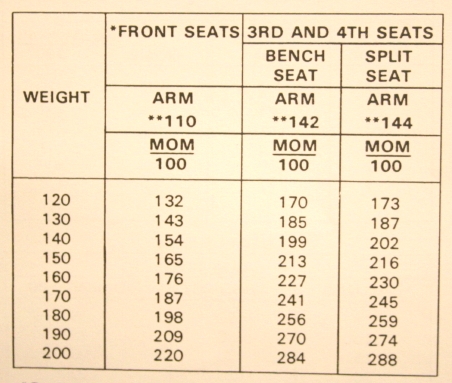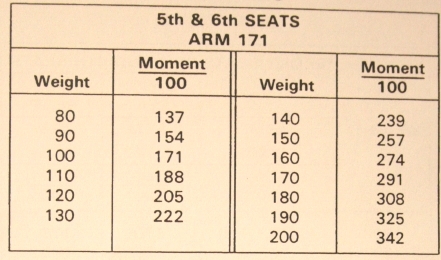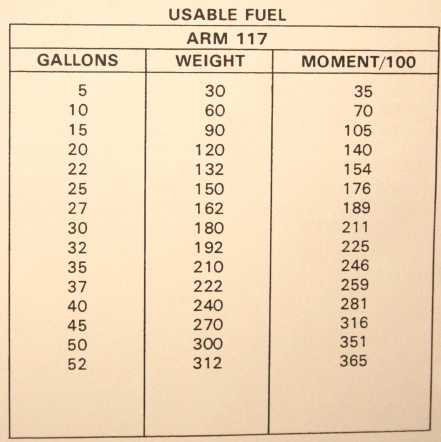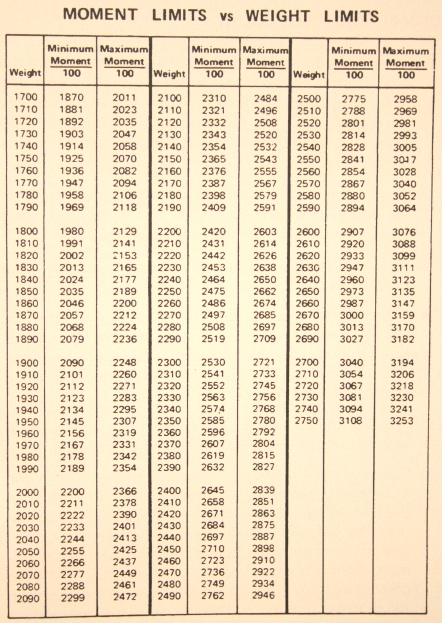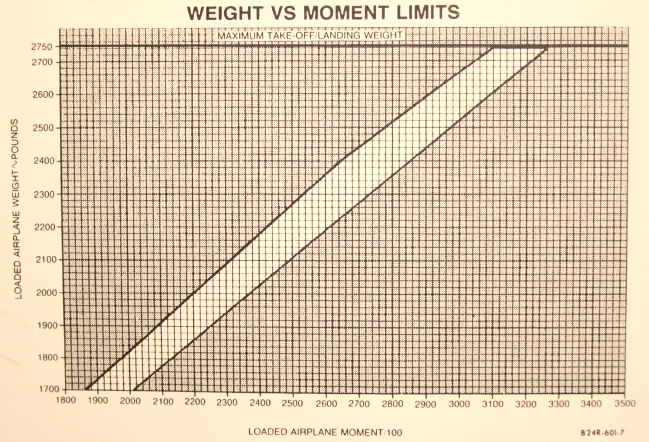If the manufacturer of the airplane your flying uses the table method, you will refer to several tables to determine the moments of items you plan to load. As with the other methods, the weights and moments will then be added and compared to an envelope or chart, which will tell you if the weight and balance is acceptable.
The following example uses charts from the handbook of a Beech Sierra. We'll say we have a pilot and front passenger of 180 pounds each, and a 3rd seat passenger weighing 150 pounds. Using the chart below, we can see the moment of each 180 pound passenger is 198. On the airplane we'll be flying, we have the bench style seat, which yields a 3rd passenger moment of 213.
The 5th and 6th seats will be unoccupied for this flight. If they were occupied, however, the chart below would be used to obtain moments for the 5th and 6th seats.
Now to add the fuel. We will take full fuel, 52 gallons. The chart below shows a takeoff fuel weight of 312 and a moment of 365. After we perform our performance calculations for the flight, we determine we will land with 31 gallons of fuel on board. So, our landing fuel weight will be 186 pounds with a moment of 218.
We will also take a 30 pound bag. The chart below shows this airplane's baggage moments. Our 30 pound bag has a moment of 50.
Now we will add everything up to see if the weight and balance is good. The empty weight and moment(over 100) of this airplane is 1720 pounds and 1912 pound-inches. Two front passengers at 360 pounds plus a 3rd 150 pound passenger and a 30 pound bag adds to 540 pounds. The fuel weight is 312 at takeoff and 186 pounds at landing. Adding this all up shows the takeoff weight to be 2572 pounds, with a landing weight of 2446. The moments add to show a takeoff moment of 2936 and a landing moment of 2789.
The graph below shows us for a weight of 2570, the moment must lie between 2867 and 3040 to be acceptable. At 2580 pounds, the acceptable moment range is 2880 to 3052. I chose to look at the moment ranges for 2570 and 2580, because our takeoff weight of 2572 lies between the two.
If we take the most conservative values of each range, we can safely consider the acceptable moment range for any weight between 2570 and 2580 to be 2880 and 3040. Our takeoff moment is 2936, so we are good and do not have to worry about interpolation.
To prove it, interpolation yields an acceptable moment 2869.2 to 3042.2. Our takeoff moment of 2936 lies between these two values and is acceptable.
Our takeoff weight of 2572 is also below the maximum takeoff weight of 2750.
The moment range at our landing weight of 2446 is 2710 to 2887 (2704.8 to 2893.6 if we interpolate). Our landing moment of 2789 is between these two values. There is no landing weight limitation for this airplane, so our weight and balance is good from takeoff through landing.
Alternatively, we can plug our takeoff and landing weights and moments into this graph. The takeoff weight and moment of 2572 and 2936 intersect inside the non-shaded portion of the graph. The landing weight and moment of 2446 and 2789 also lie in the acceptable area of the graph.
Notice that the weight and balance charts and graphs for this airplane were all given with the moment divided by 100. Since we dealt with moment divided by 100 consistently throughout the example problem, this was not a factor in our calculations.
